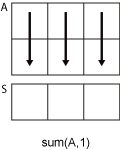hdl.treeprod
Description
B = hdl.treeprod(A)
If
Ais a vector, thenhdl.treeprod(A)returns the product of the elements.If
Ais a matrix, thenhdl.treeprod(A)returns a row vector containing the products of each column.
The function hdl.treeprod uses a tree architecture to multiply
elements. The tree architecture multiplication yields a shorter critical path, which leads
to reduced latency when generating HDL code from a MATLAB Function block.
When generating HDL code, the function hdl.treeprod reduces the amount
of matching delays required to multiply elements.
Examples
Input Arguments
Output Arguments
Extended Capabilities
Version History
Introduced in R2022a

